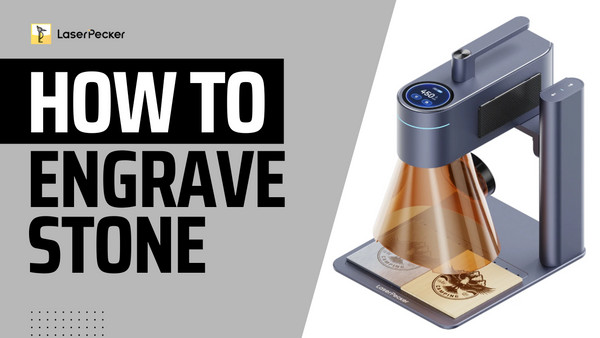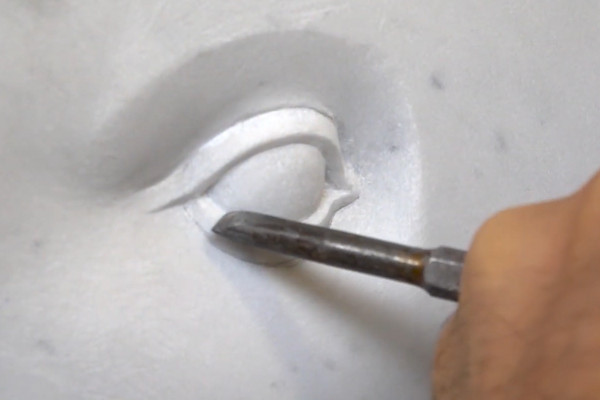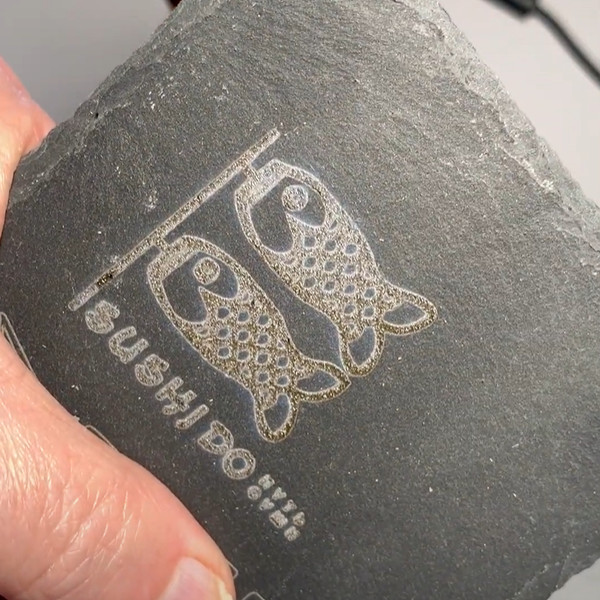Engraving rocks and stones allows you to create personalized and lasting artistic pieces, readily available in nature, and at rockscapes.net we can help you do just that! With the right tools, skills, and a little practice, you can create beautiful designs on stones for your home, garden, or as cherished gifts. Dive in with us as we explore various engraving techniques and how to apply them to different types of rocks and stones, turning ordinary finds into extraordinary keepsakes.
1. Understanding Stone Engraving Techniques
Stone engraving involves several methods, each offering unique results. Understanding these techniques is crucial for achieving the desired aesthetic and durability in your rock and stone projects. Whether you prefer the precision of laser engraving, the versatility of a Dremel, or the traditional approach of hand carving, knowing the ins and outs of each method will ensure a successful outcome.
1.1 Laser Engraving on Stone
Laser engraving uses a concentrated beam of light to etch designs onto the surface of various stones. This method offers precision, durability, and the ability to create intricate designs that enhance the stone’s natural beauty.
- Precision and Detail: Laser engraving provides unmatched precision, making it ideal for detailed designs, intricate patterns, and even photographic images on stone.
- Durability: The engravings are permanent and resistant to wear, ensuring that your designs last for years to come.
- Versatility: This technique works on various types of stone, including granite, marble, and slate, offering flexibility in your creative projects.
 Laser Engraving on Stone
Laser Engraving on Stone
1.2 Stone Engraving with a Dremel
Engraving stone with a Dremel tool offers a versatile and accessible method to create intricate designs or patterns on various types of stones. This technique provides a hands-on approach, allowing for artistic expression and customization while requiring basic tools and a steady hand for precise engraving.
- Accessibility: Dremel tools are widely available and relatively affordable, making this method accessible for hobbyists and DIY enthusiasts.
- Customization: You have direct control over the engraving process, allowing for unique, handcrafted designs.
- Versatility: Dremels can be used on various stone types, from river rocks to quartz, providing flexibility in your projects.
 Engraving Stone with a Dremel
Engraving Stone with a Dremel
1.3 Hand Engraving on Stone (Carving)
Hand engraving on stone is a traditional yet rewarding technique that allows artisans to create intricate designs, patterns, or texts on various types of stones using manual tools. This method offers a hands-on approach, providing a unique level of craftsmanship and precision while requiring skill and patience for optimal results.
- Traditional Craftsmanship: Hand engraving provides a unique connection to traditional stone carving techniques, offering a sense of artistic fulfillment.
- Precision and Control: Skilled artisans can achieve exceptional detail and precision through careful hand carving.
- Unique Aesthetic: Hand-carved stones have a distinct, timeless quality that cannot be replicated by machine methods.
 Hand Engraving on Stone
Hand Engraving on Stone
2. Essential Tools and Materials for Stone Engraving
Before you begin engraving, it’s essential to gather the necessary tools and materials. The specific items you’ll need depend on the engraving technique you choose. Having the right equipment will not only make the process smoother but also ensure the quality and safety of your work.
2.1 Tools for Laser Engraving
Laser engraving requires specialized equipment to achieve precise and durable results. Here’s a list of essential tools:
| Tool | Description |
|---|---|
| Stone Laser Engraving Machine | Choose a laser engraving machine suitable for stone engraving, considering its power and engraving area. |
| Laser Engraving Software | Use design software compatible with the laser engraving machine to create or import designs. |
| Protective Gear | Equip yourself with safety goggles and gloves to shield against laser exposure and debris. |
| Cleaning Materials | Isopropyl alcohol, water, and a soft cloth for cleaning the stone surface before and after engraving. |
2.2 Tools for Dremel Engraving
Engraving with a Dremel tool is more accessible and requires a different set of tools:
| Tool | Description |
|---|---|
| Dremel Rotary Tool | Select a Dremel tool with variable speed settings and a variety of compatible attachments suitable for stone engraving. |
| Engraving Bits | Carbide or diamond-tipped engraving bits of different shapes and sizes for cutting and detailing. |
| Safety Gear | Safety goggles to protect eyes from debris and a dust mask for respiratory safety. |
| Stabilization Tools | Clamps or a secure workstation to hold the stone in place during engraving. |
| Cleaning Materials | Water, soft cloth, and a brush to clean the stone surface. |
2.3 Tools for Hand Engraving
Hand engraving requires a more traditional set of tools and a higher level of skill:
| Tool | Description |
|---|---|
| Chisels | Various sizes and shapes of chisels with carbide or steel tips for cutting and carving on stone. |
| Hammers or Mallets | Used to strike the chisels gently for controlled and precise engraving. |
| Safety Gear | Safety goggles, gloves, and a dust mask to protect against debris and ensure personal safety. |
| Cleaning Materials | Water, soft cloth, and a brush to clean the stone surface during and after engraving. |
3. Step-by-Step Guide to Laser Engraving Stone
Laser engraving is an advanced technique that yields precise and durable results. Here’s a detailed guide to help you through the process:
3.1 Preparing the Design
The first step in laser engraving is creating or importing your design into the laser engraving software. This involves:
- Creating a Design: Use graphic design software to create your desired pattern, text, or image.
- Importing a Design: Alternatively, import an existing design file into the laser engraving software.
- Adjusting Dimensions: Ensure the design fits the stone’s dimensions and adjust the position for optimal engraving.
3.2 Preparing the Stone
Properly preparing the stone is essential for achieving a clean and precise engraving:
- Cleaning the Surface: Thoroughly clean the stone surface to remove any dust, dirt, or debris that could interfere with the engraving process.
- Securing the Stone: Place the stone securely within the engraving machine’s working area to prevent movement during the engraving process.
- Adjusting the Focus: Adjust the laser focus to ensure the beam is optimally aligned for the stone’s surface.
3.3 Setting Up the Laser Engraving Machine
Configuring the laser settings is crucial for achieving the desired engraving depth and quality:
- Power Settings: Adjust the laser power based on the type of stone you are engraving. Softer stones require lower power settings, while harder stones require higher settings.
- Speed Settings: Set the engraving speed to control the detail and depth of the engraving. Slower speeds result in deeper, more detailed engravings.
- Resolution: Adjust the resolution to achieve the desired level of detail in your design. Higher resolution settings result in finer details but may increase engraving time.
3.4 Testing and Calibration
Before starting the full engraving, it’s important to test your settings:
- Test Engraving: Perform a test engraving on a small, inconspicuous area of the stone to verify the settings and make any necessary adjustments.
- Calibration: Calibrate the machine to ensure optimal engraving results, adjusting the focus and alignment as needed.
 Testing Laser Engraving on Stone
Testing Laser Engraving on Stone
3.5 Commencing the Engraving Process
Once everything is set up, you can start the engraving:
- Starting the Engraving: Start the engraving process through the software interface, allowing the laser to follow the designed pattern or text on the stone surface.
- Monitoring the Process: Monitor the process for any unexpected issues, such as misalignment or inconsistent engraving depth, and make adjustments as needed.
3.6 Post-Engraving Care
After the engraving is complete, follow these steps:
- Removing the Stone: Carefully remove the stone from the machine, taking care not to damage the engraved area.
- Cleaning the Engraved Area: Clean the engraved area with isopropyl alcohol or water and a soft cloth to remove any residue or marks.
- Inspection: Inspect the engraved design for quality and completeness, making any necessary touch-ups.
3.7 Inspection and Finishing
To complete the process:
- Applying Sealant: Apply a sealant or polish to enhance the appearance and durability of the engraving, if desired.
- Final Inspection: Perform a final inspection to ensure the engraving meets your expectations.
4. Step-by-Step Guide to Engraving Stone with a Dremel
Using a Dremel tool is a versatile and accessible way to engrave stones. Here’s a step-by-step guide to help you get started:
4.1 Design Preparation
Start by preparing your design:
- Sketching the Design: Sketch or transfer your design onto the stone surface using a pencil or marker as a guideline.
- Keeping it Simple: Opt for a simple design at first.
- Considering the Stone Shape: Factor the stone shape into the design.
4.2 Selecting the Engraving Bit
Choosing the right bit is crucial:
- Choosing the Bit: Choose an appropriate engraving bit based on the size and intricacy of the design, ensuring it’s compatible with the Dremel tool.
- Opting for Carbide: Carbide tips are cost effective and work well for many types of stone.
- Consider Diamond: Consider diamond tips for harder stones.
4.3 Stone Preparation
Prepare the stone for engraving:
- Cleaning the Stone: Clean the stone thoroughly to remove dirt, dust, or debris from the surface.
- Securing the Stone: Securely fasten the stone onto a stable surface or clamp it to prevent movement during engraving.
- Checking the Stone: Check for cracks or imperfections.
4.4 Setting Up the Dremel
Prepare the Dremel tool:
- Inserting the Bit: Insert the selected engraving bit into the Dremel tool and tighten it securely.
- Adjusting Speed: Adjust the speed settings as needed for precise control. Lower speeds are better for intricate details, while higher speeds are suitable for removing larger amounts of material.
- Practicing First: Before engraving, practice on a scrap piece of stone to get a feel for the tool and the chosen bit.
4.5 Commencing the Engraving Process
Begin the engraving:
- Tracing the Design: Begin engraving by lightly tracing the design outlines on the stone using the Dremel tool.
- Holding Steady: Maintain a steady hand and apply consistent pressure for even lines.
- Adjusting Pressure: Gradually deepen the engraved lines or areas, adjusting the pressure and angle of the Dremel tool for desired depth and detail.
4.6 Detailing and Finishing
Add details to your engraving:
- Working on Details: Work on intricate details by changing the engraving bit if necessary to achieve finer lines or shading.
- Taking Your Time: Take your time and focus on precision.
- Cleaning Regularly: Clean the stone periodically during the process to remove debris and better visualize the engraved design.
4.7 Post-Engraving Care
After engraving, take care of the stone:
- Wiping the Stone: Once the engraving is complete, wipe the stone surface with a damp cloth to remove any leftover dust or residue.
- Inspecting the Design: Inspect the engraved design for clarity and depth, making any necessary touch-ups.
4.8 Optional Finishing Touches
Enhance the appearance of your engraved stone:
- Applying Sealant: Apply sealant or polish to enhance the appearance and longevity of the engraved stone if desired.
- Adding Paint: Consider adding paint to highlight the design.
- Polishing: Polish the surface to create a smooth finish.
5. Step-by-Step Guide to Hand Engraving Stone (Carving)
Hand engraving is a traditional method that requires patience and skill. Here’s how to do it:
5.1 Design Preparation
Start with a clear plan:
- Sketching the Design: Sketch or transfer the desired design onto the stone surface using a pencil or marker as a guide for engraving.
- Considering Your Skill: Opt for a design that suits your skill level.
- Using Stencils: Consider using stencils to make the design transfer easier.
5.2 Selecting the Chisel
Choose the right tools for the job:
- Selecting Chisels: Choose appropriate chisels based on the design complexity. Larger chisels for broader strokes and smaller ones for fine detailing.
- Using a Variety: Use a variety of chisel shapes (flat, pointed, rounded) to achieve different effects.
- Keeping Sharp: Make sure the chisel is sharp.
5.3 Stone Preparation
Prepare the stone:
- Cleaning the Stone: Ensure the stone surface is clean and free of debris.
- Securing the Stone: Securely position the stone on a stable surface or workbench.
- Ensuring Stability: Ensure the stone is stable and won’t move during engraving.
5.4 Starting the Engraving Process
Begin the carving process:
- Holding the Chisel: Begin engraving by holding the chisel at a slight angle to the stone’s surface.
- Striking Gently: Use controlled strikes with the hammer or mallet to create indentations following the design outlines.
- Gradually Deepening: Gradually deepen the engraved lines by repeating the process, adjusting pressure and angle for depth and detail.
5.5 Detailing and Refinement
Refine your design:
- Working on Details: Work on intricate details by using smaller chisels or adjusting the angle and force of the strikes.
- Taking Breaks: Take breaks to assess progress and ensure the design is evolving as intended.
- Adjusting Technique: Adjust the tool you use.
5.6 Cleaning and Inspection
Keep the stone clean:
- Cleaning Regularly: Periodically clean the stone surface with water and a soft cloth to remove debris and better visualize the engraved design.
- Inspecting Regularly: Inspect the engraved lines for consistency and clarity, making necessary adjustments as you proceed.
5.7 Post-Engraving Care
Final steps:
- Cleaning Thoroughly: Once the engraving is complete, clean the stone surface thoroughly to remove any remaining dust or debris.
- Applying Sealant: Optionally, use a sealant or polish designed for stones to enhance the appearance and protect the engraved surface.
- Cleaning with a Brush: Use a soft brush to clean the engravings.
6. How to Engrave Different Stones and Rocks
Each type of stone requires specific techniques to achieve the best results. Understanding the properties of different stones is crucial for successful engraving.
6.1 How to Engrave Slate
Slate is a fine-grained, metamorphic rock that is relatively soft and easy to engrave. Its smooth surface makes it ideal for detailed designs.
- Tool Selection: Use fine-tipped engraving bits or diamond-tipped tools suited for slate engraving. Diamond burrs work well for intricate designs.
- Technique: Keep a steady hand and apply consistent pressure while engraving slate. Opt for shallow, delicate cuts as slate can be prone to chipping.
- Test Engraving: Prior to the main design, practice engraving on a small slate piece to understand the depth and texture control needed.
- Ideal Uses: Slate is commonly used for decorative plaques, coasters, and personalized gifts due to its smooth finish and dark color, which provides a nice contrast for engravings.
6.2 How to Engrave Granite
Granite is a hard, igneous rock known for its durability and coarse texture. Engraving granite requires more robust tools and techniques.
- Durable Engraving Bits: Employ harder materials like tungsten carbide or diamond-tipped engraving bits for granite, as it’s a tough stone.
- Speed and Pressure: Use a moderate speed setting on the engraving tool and apply firm but not excessive pressure to achieve clean, precise lines.
- Cooling Breaks: Take intermittent breaks during granite engraving to prevent overheating of the tool and stone, ensuring better results.
- Ideal Uses: Granite is frequently used for memorial stones, signage, and architectural details because of its strength and resistance to weathering.
6.3 How to Engrave Marble
Marble is a metamorphic rock known for its smooth texture and elegant appearance. It is softer than granite but harder than slate, requiring a gentle touch during engraving.
- Gentle Touch: Marble is softer compared to granite, so use lighter pressure when engraving to avoid creating deep or unintended marks.
- Fine Detailing: Opt for smaller engraving bits for intricate details on marble. Test the depth and pressure before starting the main design.
- Surface Preparation: Ensure the marble surface is clean and free of debris to prevent scratches or inconsistencies during engraving.
- Ideal Uses: Marble is often used for decorative items, sculptures, and personalized gifts due to its luxurious appearance and ability to hold fine details.
6.4 How to Engrave Sandstone
Sandstone is a sedimentary rock composed of sand-sized grains of mineral, rock, or organic material. It is relatively soft and porous, requiring careful handling during engraving.
- Low-Speed Engraving: Sandstone is delicate, requiring slower speed settings on the engraving tool to avoid damaging the stone’s surface.
- Patience with Pressure: Apply gentle and consistent pressure while engraving sandstone. Avoid excessive force to prevent chipping or cracking.
- Deep Etching Caution: Be cautious with deep etching on sandstone, as it can weaken the stone structure. Opt for shallow engraving for best results.
- Ideal Uses: Sandstone is commonly used for garden stones, decorative art, and rustic signage, thanks to its natural appearance and warm color tones.
6.5 How to Engrave Limestone
Limestone is a sedimentary rock composed mainly of calcium carbonate. It is relatively soft and easy to carve, making it a popular choice for engraving.
- Careful Tool Selection: Choose engraving bits suited for softer stones to avoid causing damage. Diamond-tipped or carbide bits with smaller tips work well.
- Surface Testing: Test a small area of the limestone surface to understand how the stone reacts to engraving depth and pressure.
- Light Pressure Engraving: Use light and consistent pressure to prevent the stone from chipping or flaking while engraving limestone.
- Ideal Uses: Limestone is frequently used for architectural details, garden ornaments, and personalized gifts due to its smooth texture and light color, which provides a nice contrast for engravings.
7. Safety Precautions for Stone Engraving
Safety should always be a top priority when engraving stones. Here are some essential safety precautions to keep in mind:
- Wear Safety Goggles: Always wear safety goggles to protect your eyes from flying debris and dust.
- Use a Dust Mask: Wear a dust mask to prevent inhalation of stone dust, which can be harmful to your respiratory system.
- Wear Gloves: Wear gloves to protect your hands from sharp edges and potential cuts.
- Work in a Well-Ventilated Area: Ensure that you are working in a well-ventilated area to minimize exposure to dust and fumes.
- Secure the Stone: Secure the stone properly to prevent it from moving or slipping during engraving.
- Follow Manufacturer’s Instructions: Always follow the manufacturer’s instructions for your tools and equipment.
- Take Breaks: Take frequent breaks to avoid fatigue and maintain focus during engraving.
8. Design Ideas and Inspiration
Need some inspiration for your stone engraving projects? Here are a few design ideas to get you started:
- Personalized Gifts: Engrave names, dates, or special messages on stones to create unique and heartfelt gifts for friends and family.
- Garden Stones: Create decorative garden stones with inspiring quotes, plant names, or whimsical designs to add character to your outdoor space.
- Memorial Stones: Engrave memorial stones with names, dates, and epitaphs to honor loved ones.
- Home Décor: Create personalized home décor items, such as engraved coasters, plaques, or decorative stones, to add a personal touch to your living space.
- Pet Memorials: Create personalized memorials for beloved pets with their names, dates, and paw prints engraved on stones.
9. Maintaining Your Engraved Stones
Proper maintenance is essential to preserve the beauty and longevity of your engraved stones. Here are some tips for maintaining your engraved stones:
- Clean Regularly: Clean your engraved stones regularly with a soft brush and mild soap and water to remove dust and dirt.
- Avoid Harsh Chemicals: Avoid using harsh chemicals or abrasive cleaners, as they can damage the engraved surface.
- Apply Sealant: Apply a sealant or polish designed for stones to protect the engraved surface from weathering and wear.
- Store Properly: Store your engraved stones in a dry, protected area to prevent damage from moisture and extreme temperatures.
10. FAQs About Stone Engraving
Here are some frequently asked questions about stone engraving:
10.1 Can any type of stone be engraved?
While many stones can be engraved, some are easier to work with than others. Granite, marble, slate, sandstone, and limestone are commonly used for engraving due to their varying hardness and texture.
10.2 How to engrave stone at home?
Using tools like chisels, Dremel tools, or a laser engraving machine, you can create designs on stones. Ensure you have safety gear and practice on small stones first. Working in a well-ventilated area is important due to dust.
10.3 Where can I find resources or tutorials to learn stone engraving?
You can find online tutorials, instructional videos, and community forums dedicated to stone engraving. Additionally, local craft stores or workshops might offer classes or guidance on getting started with stone engraving.
10.4 What is the best method for engraving hard stones like granite?
Laser engraving and using a Dremel with diamond-tipped bits are effective methods for engraving hard stones like granite. These methods provide the necessary power and precision to create lasting designs.
10.5 How do I prevent chipping when engraving softer stones like sandstone?
To prevent chipping when engraving softer stones like sandstone, use low-speed settings on your engraving tool, apply gentle and consistent pressure, and avoid deep etching.
10.6 What type of sealant should I use to protect my engraved stones?
Use a sealant specifically designed for stones to protect your engraved stones from weathering and wear. Look for sealants that are water-based and non-yellowing to maintain the stone’s natural appearance.
10.7 How do I clean engraved stones without damaging the design?
Clean engraved stones with a soft brush and mild soap and water. Avoid using harsh chemicals or abrasive cleaners, as they can damage the engraved surface. Rinse thoroughly and allow to dry completely.
10.8 Can I engrave curved or uneven stone surfaces?
Yes, you can engrave curved or uneven stone surfaces, but it may require additional techniques and tools. For laser engraving, you may need a rotary attachment to ensure consistent focus. For Dremel and hand engraving, you may need to adjust your approach to follow the contours of the stone.
10.9 What are some common mistakes to avoid when engraving stones?
Common mistakes to avoid when engraving stones include using too much pressure, selecting the wrong tools, neglecting safety precautions, and not properly preparing the stone surface.
10.10 How can I add color to my engraved stone designs?
You can add color to your engraved stone designs by using paint, ink, or epoxy. Apply the color carefully to the engraved areas and wipe away any excess from the surrounding surface.
Conclusion: Unleash Your Creativity with Stone Engraving
Stone engraving offers a fantastic way to express your creativity and create unique, personalized items. Whether you choose laser engraving, Dremel engraving, or hand carving, the possibilities are endless. Remember to prioritize safety, select the right tools and techniques for the type of stone you are working with, and take your time to achieve the best results.
Ready to start your stone engraving journey? Visit rockscapes.net for inspiration, tools, and expert advice to help you create stunning rock and stone art. Explore our wide selection of stones and discover new design ideas to transform ordinary rocks into extraordinary treasures. Let rockscapes.net be your partner in bringing your creative vision to life. Contact us today at 1151 S Forest Ave, Tempe, AZ 85281, United States, or call +1 (480) 965-9011. Happy engraving!
